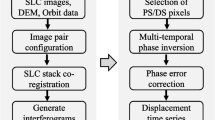Abstract
More than 40 groups from 10 different countries participated in a weak- and strong-motion prediction experiment at Ashigara Valley which required the blind prediction of time series, spectra and spectral ratios for selected and instrumented sedimentary sites with well-known geotechnical properties. The wide scatter of the results of this experiment have raised a number of questions as to how to model high-frequency ground motion in the presence of available geotechnical and geophysical data. Using a simulated annealing waveform inversion method, we have tried to optimize and automate the model construction for ID site-dependent ground-motion simulation. We found a whole set of successfull models which provide good waveform fit (r > 0.8) for the observed displacement records at site KS2 but also yield sufficiently accurate response spectra and peak value predictions for both surface and downhole site. This shows that ID models are fully adequate to model the site conditions at least for the weak motion data. The resulting ‘successful’ layer models consistently show a slower, less dense, and slightly thicker low velocity coverage with stronger damping than the official geotechnical model. Furthermore, their statistical properties directly measure the sensitivity of the individual parameters for the simulations. The critical re-evaluation of our own prediction which was based on stochastic simulation shows that although this approach has its greatest merits in situations where little information is available, it can also be successfully applied to model individual records if sufficient care is taken to determine the source parameters. Simulated annealing waveform inversion has shown to be a powerful tool to optimize that process.
Similar content being viewed by others
References
Basu, A. and Frazer, L. N.: 1990, Rapid determination of the critical temperature in simulated annealing inversion,Science 249, 1409–1412.
Boore, D. M.: 1983, Stochastic simulation of high frequency ground motions based on seismological models of radiated spectra,Bull. Seismol. Soc. Am. 73, 1865–1894.
Brune, J. N.: 1970, Tectonic stress and the spectra of seismic shear waves from earthquakes,J. Geophys. Res. 76, 4997–5009.
Brune, J. N.: 1971, Correction,J. Geophys. Res. 76, 4997–5009.
Cramer, C. H. and Real, C. R.: 1991, A statistical analysis of submitted site effect predictions for the weak-motion blind prediction test conducted at the Turkey Flat, U.S.A., site-effects test area near Parkfield, California,Proc. Fourth Intern. Conf. Seismic Zonation, Vol II, pp. 467–474.
Cranswick, E., Wetmiller, R., and Boatwright, J.: 1985, High-frequency observations and source parameters of microearthquakes recorded at hard-rock sites,Bull Seismol. Soc. Am. 75, 1535–1567.
Haskell, N.: 1960, Crustal reflection of plane SH waves,J. Geophys. Res. 65, 4147–4150.
Hanks, T. C.: 1982,f max,Bull. Seismol. Soc. Am. 72, 1867–1879.
Hardt, M. and Scherbaum, F.: 1994, The design of optimum networks for aftershock recordings,Geophys. J. Int., submitted.
Kunze, T., Langer, H., Scherbaum, F., and Schneider, G.: 1986, Site dependent strong ground motion simulation, in A. Vogel and K. Brandes (eds.),Earthquake Prognostics, Vieweg & Sohn, Braunschweig/Wiesbaden, pp. 157–177.
Midorikawa, S.: 1992, A statistical analysis of submitted predictions for the Ashigara Valley blind prediction test, The Subcommittee for the Prediction Criteria of the Ashigara Valley Blind Prediction Test, inProc. Int. Symp. on the Effects of Surface Geology on Seismic Ground Motion, 25–27 March 1992, Odawara, Japan, Vol. II, pp. 65–77.
Press, W. H., Flannery, B. P., Teukolsky, S. A., and Vetterling, W. T.: 1988,Numerical Recipes in C, Cambridge University Press, Cambridge.
Sato, H.: 1989, Broadening of seismogram envelopes in the random inhomogeneous lithosphere based on the parabolic approximation: SE Honshu, Japan,J. Geophys. Res. 94, 17735–17747.
Sasatani, T.: 1992, Methodology of response analyses used for the Ashigara Valley blind predictions, The Subcommittee for the Prediction Criteria of the Ashigara Valley Blind Prediction Test, inProc. Int. Symp. on the Effects of Surface Geology on Seismic Ground Motion, 25–27 March 1992, Odawara Japan, Vol. II, pp. 61–64.
Sawada, Y.: 1992, Geotechnical data, The Subcommittee for the Geotechnical Survey of the Ashigara Valley Blind Prediction Test, inProc. Int. Symp. on the Effects of Surface Geology on Seismic Ground Motion, 25–27 March 1992, Odawara Japan, Vol. II, pp. 29–42.
Shibuya, J.: 1992, Summary and concluding remarks of the panel discussion on the Ashigara Valley blind prediction, inProc. Int. Symp. on the Effects of Surface Geology on Seismic Ground Motion, 25–27 March 1992, Odawara, Japan, Vol. III, pp. 43–45.
Scherbaum, F.: 1990, Combined inversion for the three-dimensional Q structure and source parameters using microearthquake spectra,J. Geophys. Res. 95, 12423–12438.
Scherbaum, F. and Sato, H.: 1991, Inversion of full seismogram envelopes based on the parabolic approximation: Estimation of randomness and attenuation in SE Honshu, Japan,J. Geophys. Res. 96, 2223–2232.
Scherbaum, F., Palme, C., and Langer, H.: 1992, Prediction of ground motions at Ashigara Valley using a site dependent stochastic simulation method, inProc. Int. Symp. on the Effects of Surface Geology on Seismic Ground Motion, 25–27 March 1992, Odawara, Japan, Vol. II, pp. 131–132.
Sen, M. K. and Stoffa, P. L.: 1991, Nonlinear one-dimensional seismic waveform inversion using simulated annealing,Geophysics 56, 1624–1638.
Toksöz, M. N., Dainty, A. M., and Coates, R.: 1992, Effects of Lateral Heterogeneities on Seismic Motions, inProc. Int. Symp. on the Effects of Surface Geology on Seismic Ground Motion, 25–27 March 1992, Odawara, Japan, Vol. II, pp. 33–64.
Author information
Authors and Affiliations
Rights and permissions
About this article
Cite this article
Scherbaum, F., Palme, C. & Langer, H. Model parameter optimization for site-dependent simulation of ground motion by simulated annealing: Re-evaluation of the Ashigara Valley prediction experiment. Nat Hazards 10, 275–296 (1994). https://doi.org/10.1007/BF00596147
Received:
Revised:
Issue Date:
DOI: https://doi.org/10.1007/BF00596147




